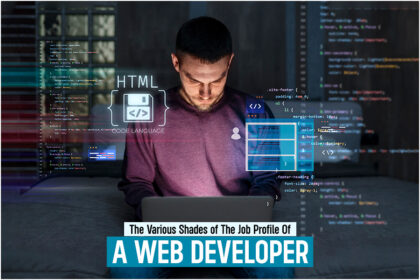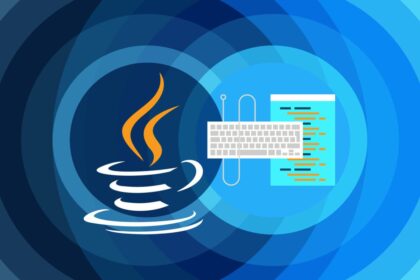
The usual question arises, “What course should I do?”
At this moment, you may be considering taking a course but feel unsure where to begin.
You’re not alone.
Many people hesitate. Some aren’t sure what to learn, others are worried the course won’t be worth the effort.
Especially if you’re a student, it’s common to feel discouraged by the idea of spending time and money on something that may not lead to real outcomes. It’s a valid concern.
That’s why it’s important to look closely at what a course offers and how it can directly support your goals. So, let figure out if an AngularJS course is relevant for you. This guide will walk you through exactly that.
What is AngularJS?
AngularJS is a framework for building websites and web apps. That means it’s a set of rules and tools that helps you create parts of a web app that users can interact with, like forms, buttons, or entire dashboards.
When you use AngularJS, you won’t have to write everything from scratch. You will be working on a structure that makes it easier to build web applications that are fast and highly organized. It’s not a design tool.
The point is not just to make apps look good but to ensure that they function to their highest potential.
AngularJS for web development is especially useful when you’re working with data and need things to update on screen without reloading the page. This is why many developers choose AngularJS for web development.
What Will You Actually Learn in an AngularJS Course?
1. How AngularJS Works
At the start, instructors will explain what AngularJS is and what kind of websites use it. They won’t throw you into code right away.
First, you’ll understand what this tool is made for and why companies use it. It will also cover what a “framework” is and how this one helps you build things on the web. The idea is to give you a basic grip on it before doing all the practical steps.
Later, you’ll also go into the parts that make up an AngularJS app—things like modules, components, and views. These names might sound odd now, but each one will be spilt and taught to you clearly.
It’s quite exciting to see how these pieces fit together to create working apps. This gives you a mental map to follow, so you have all the information you need when you get into the advanced topics. Many AngularJS training institute companies start with this exact foundation.
2. Writing and Using Templates
Templates are the parts of the page users can see, including the text boxes, buttons, and labels. You’ll learn how to write these in a way that AngularJS understands.
So, if you want to show someone’s name on a page, you’ll learn how to pull that name from your data and show it where it belongs. This section is about building what people interact with. You’ll also understand how it ties into a larger AngularJS course.
As you keep working on templates, you’ll learn how to include logic inside them. For example, how to only show something when a condition is true, or how to loop through a list of items.
These things make your pages dynamic, not just static designs. You’ll practice this a few different ways so the concept gets grasped.
3. Understanding and Using Controllers
Now comes the part that makes the page do something. Let’s say someone clicks a button—what should happen next? That’s what controllers do.
You’ll be taught how to write simple code that tells your website what to do when users click, type, or move around. It sounds tricky, but you’ll be shown small examples to practice on until it clicks.
In addition to writing them, you’ll also learn where to put your controllers and how to keep them organized. This is important as your project grows. The course also prepares you to apply this knowledge in real-world jobs related to a career in AngularJS.
You’ll see examples of what not to do too (like mixing everything in one file). By the end, you’ll be able to split your code clearly and avoid getting stuck later.
4. Two-Way Data Binding
This means your webpage and your data are always connected. If you change one, the other updates too. So, if a user types something in a form, it changes the actual data behind the scenes.
And if the data changes, the screen changes too. This saves time.
The course will explain how to set that up properly, and you’ll do it yourself a few times until you understand how it works.
Two-way binding saves you a lot of code. In other frameworks, you often need to write separate code to update the view and the data.
With AngularJS, it’s more automatic. Once you see this in action you will understand why this feature made AngularJS popular in the first place.
This is something you’ll experience directly if you learn AngularJS online through a well-structured platform.
5. Working with Built-In Directives
AngularJS gives you a bunch of tools that are already built in. These help you do things like repeat items in a list or hide something until the right moment.
Expert trainers will show you how to use these, when to use them, and what to avoid. They’ll give you examples like showing a warning message only when something goes wrong, or displaying items from a database.
Through practise you will write code using different combinations of these built-in directives. That way you don’t just understand each one alone, but how they work together. AngularJS course training includes this topic heavily.
Over time, using directives like ng-if, ng-repeat, and ng-model will become second nature because you’ll have done them over and over in short, clear exercises.
6. Creating and Using Custom Directives
Sometimes, the built-in stuff isn’t enough. You’ll need to create your own tools. These are called custom directives. You’ll learn how to make them and how they fit into the app as whole.
This takes a bit more time to get used to, but once you learn it, your code becomes easier to manage and reuse.
By the time you get here, the idea of writing your own directives won’t feel so out of reach. Practical exercises may involve using directives to create a custom dropdown or alert box—and see how you can repeat that piece in different parts of the app without coding it all again. This is one area where a comprehensive AngularJS course in Kolkata can give local learners a significant edge.
7. Handling Forms and Validation
Forms are things like login screens, sign-ups, search bars. You’ll learn how to build those and check if the user entered details the right way.
In case someone forgets to type in their email, the site should stop them. AngularJS experts will teach you how to do this using the framework. They will also show you how to make the form say what went wrong in a way the user understands.
It explains how to mark fields red or show little error messages. Another thing you’ll practise is setting rules for users to follow, like only accepting numbers or forcing a password to be a certain length.
8. Using AngularJS Routing
When people click on different parts of your website, they expect it to show different screens. But they don’t want the whole page to reload each time. Routing helps with that.
You’ll learn how to create links inside your app so users can move around smoothly. This is useful when you want one app to do many things, like show a homepage, a login page, and a profile page.
There won’t be any need to switch between separate websites.
Training will be given on how to handle mistakes. This includes things like when someone types the wrong address or tries to open a page that doesn’t exist. Setting up default routes, fallback pages, and links that work correctly are all part of this topic.
9. Connecting to External Data
Most sites need to get data from somewhere else (maybe a server or maybe a database). You’ll be shown how to connect your app to outside sources.
This means if you want to display live data (like a list of users or recent orders), you can pull it in and show it without having to refresh anything. They’ll teach you how to ask for the data, wait for it, and then use it once it comes back.
Later, the process of sending data back, like submitting a form or saving a change, will be taught.
The course will guide you on how to handle the whole loop: request, wait, check if it worked, and update the screen. This is a must-know process for real-world apps.
Benefits of Learning AngularJS
1. In Demand Front-End Web Technology Skills
AngularJS is extensively used. It empowers developers to create interactive and scalable web apps.
Learning AngularJS makes you ready for numerous present-day job positions in front-end development.
The course teaches you both basic and advanced concepts, so you will be equipped to work on actual projects. Skills like these are desirable in tech firms, agencies, startups where client-side development comes into the picture.
2. No Advanced Tech Experience Required
You don’t have to be a computer coder when you begin. The course is meant for beginners and teaches concepts from scratch.
Everything is introduced with step-by-step explanations and tutored exercises. If you are new to working with code, the course makes it easy to provide the support you need to develop the foundation.
It emphasizes establishing confidence, rather than getting through material quickly. Even someone joining an AngularJS course in Kolkata with zero coding background can follow it.
3. Real-World Projects Build Confidence
Since you will work on hands-on projects, you will figure out how AngularJS is applied in a real-world workplace.
In fact, most lessons are followed by small tasks you can try right away.
It introduces you to features that mimic actual products—such as dashboards, user forms, or lists of data.
Yes, this develops your skills but it also builds your confidence in handling technical issues. By completing the course, you will have a portfolio of robust examples to present to potential employers.
4. High Salary Potential
Typically, experienced AngularJS developers are offered competitive salaries. Your skills will be in demand as you understand how to create dynamic web interfaces and manage the complete front-end process.
This course provides you with a hands-on skillset that companies desire in prospective entry-level or junior developer hires. It can increase your chances of getting interviews as well as better offers.
5. Learning Other Frameworks Becomes Simpler
Once you learn AngularJS, it becomes easier to learn other frameworks such as React or Vue. It gives you a head start.
All the modules you learn, be it components, data flow, routing, and form handling are present in practically every modern web tool.
You get a solid foundation so even the ever changing technologies in the future will never be daunting or foreign to you.
6. Certification in AngularJS Can Boost Your Career
Completing a certified course makes you more credible. It indicates that you’ve passed through an organized program and have acquired practical experience.
Certification is also useful when seeking internships, freelance work, or a junior developer position.
It provides you with an official document of your study, which is particularly useful if you’re transitioning from a non-technical background.
Getting certified by a reputed AngularJS training institute company also builds trust with employers.
Career Opportunities After an AngularJS Course
1. Front-End Developer
This is the most obvious role. You’ll be writing the parts of the website users interact with. Most front-end jobs list at least one JavaScript framework as a requirement. AngularJS is often on that list.
You won’t be stuck doing only basic UI tweaks. You’ll be expected to build sophisticated features. Taking an AngularJS course can prepare you directly for this type of work.
2. Web Application Developer
If a company has a platform that handles customer accounts, dashboards, or dynamic content, they need developers who can build those parts.
This role is about building internal tools, customer interfaces, and making sure everything works smoothly. AngularJS is commonly used here.
Many AngularJS training institutes train learners specifically for such web application roles.
3. UI Developer
Some jobs are more focused on how things feel and respond to users, even if they don’t include full-stack work. AngularJS helps here too, because it’s built for interactivity.
If you’re good at detail and want to focus on behaviour rather than visuals, this is a fit.
4. Junior Full-Stack Developer
If you choose to learn backend skills after AngularJS—like Node.js or Python—you’ll be in a position to build both the front and back of an application.
Full-stack jobs pay more, and even as a junior, knowing AngularJS puts you halfway there. An intensive AngularJS course in Kolkata can set the stage for this career path.
5. QA and Support Roles
Some tech support and QA testing jobs need people who understand how the front-end is built. AngularJS gives you enough context to test things properly, identify where bugs might be, or support customers better.
Wrapping Up
If you’re serious about switching into a tech career and want to start with real, job-ready tools, this is a smart direction.
The best part of enrolling in an AngularJS course is that you get to learn everything from basics to advanced skills.
The course material is designed in such a way that it covers all on-the-job requirements. Ultimately you get thoroughly trained in a high-demand framework, ensuring a long-term successful career in web development.
Want to finally get started?
You can go ahead and enroll in the beginner-friendly AngularJS course offered by Webskitters Academy.
Our certified trainers have industry expertise in the Angular framework, ensuring valuable guidance leading you to your chosen career.
Learn more about Webskitters Academy’s four month course today.
Search
I Want to Learn...
Category
Explore OurAll CoursesTransform Your Dreams
into Reality
Subscribe to Our Newsletter
"*" indicates required fields
 Independence Day Offer | Upto 20% Discount on all course fees
Independence Day Offer | Upto 20% Discount on all course fees 





